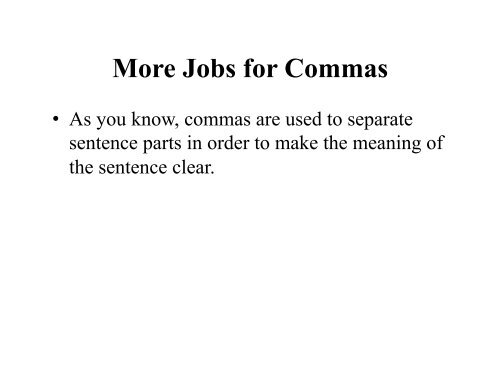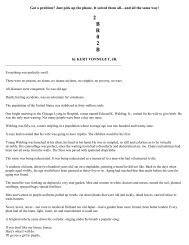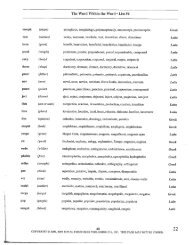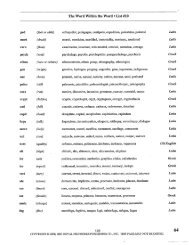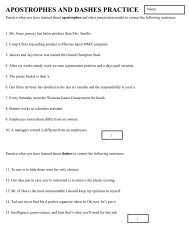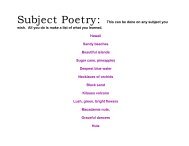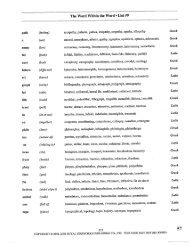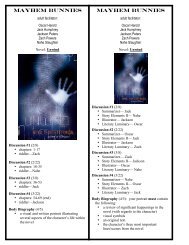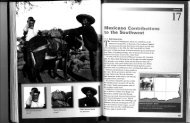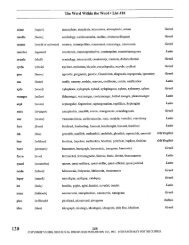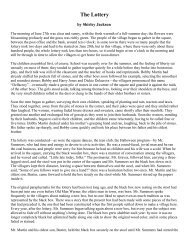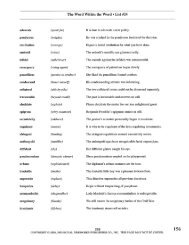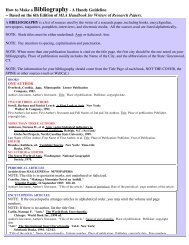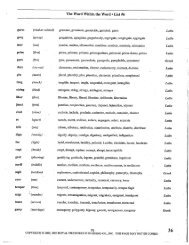More Jobs for Commas lesson
More Jobs for Commas lesson
More Jobs for Commas lesson
You also want an ePaper? Increase the reach of your titles
YUMPU automatically turns print PDFs into web optimized ePapers that Google loves.
<strong>More</strong> <strong>Jobs</strong> <strong>for</strong> <strong>Commas</strong>• You’ll also learn how to use commas in afriendly letter.
SEPARATING INDEPENDENTCLAUSES• A conjunction is ajoining word.• Here is a complete listof conjunctions thatcan be used to jointwo independentclauses:– and– <strong>for</strong>– so– but– nor– yet– or
SEPARATING INDEPENDENTCLAUSES• When two or more independent clauses arejoined with a conjunction to make a compoundsentence, a comma should follow the firstclause.• The commas and conjunctions are highlightedin the following examples.
SEPARATING INDEPENDENTCLAUSES• I wanted experience, so I operated on the manmyself.– When two or more independent clauses are joinedwith a conjunction to make a compound sentence,a comma should follow the first clause.
SEPARATING INDEPENDENTCLAUSES• Laura packed the organs carefully, but someof them still broke during the move.– When two or more independent clauses are joinedwith a conjunction to make a compound sentence,a comma should follow the first clause.
SEPARATING INDEPENDENTCLAUSES• Mandy lost her purse, and her driver’s licensewas in her wallet.– When two or more independent clauses are joinedwith a conjunction to make a compound sentence,a comma should follow the first clause.
SEPARATING INDEPENDENTCLAUSES• We told Mr. Kay about our plan; he wasn’tsure it would work.;– If independent clauses are joined without aconjunction, they are separated by a semicoloninstead of a comma.
SEPARATING INDEPENDENTCLAUSES• The company’s finances have improved; westill need to spend carefully.;– If independent clauses are joined without aconjunction, they are separated by a semicoloninstead of a comma.
SEPARATING INDEPENDENTCLAUSES• I found Susan’s address; I hadn’t seen her <strong>for</strong>months.;– If independent clauses are joined without aconjunction, they are separated by a semicoloninstead of a comma.
SEPARATING ITEMS IN ASERIES• Separating a list of similar words, phrases, orclauses makes the material easier <strong>for</strong> the readerto understand.• Usually, the last item in a series is preceded bya conjunction.• No comma is needed be<strong>for</strong>e the conjunction.• However, some writers prefer to use onebecause it helps to clarify some sentences.
SEPARATING ITEMS IN ASERIES• Gory, Sue, John, and Craig went to theconference. – Separating a list of similar words makes thematerial easier <strong>for</strong> the reader to understand.– Usually, the last item in a series is preceded by aconjunction.– No comma is needed be<strong>for</strong>e the conjunction.
SEPARATING ITEMS IN ASERIES• The horse snorted, pawed the dirt, reared up,and ran off toward hills.– Separating a list of similar phrases makes thematerial easier <strong>for</strong> the reader to understand.– Usually, the last item in a series is preceded by aconjunction.– No comma is needed be<strong>for</strong>e the conjunction.
SEPARATING ITEMS IN ASERIES• Sean taught me how to inventory theequipment, stock the shelves, and complete aquality-control check.– Separating a list of similar clauses makes thematerial easier <strong>for</strong> the reader to understand.– Usually, the last item in a series is preceded by aconjunction.– No comma is needed be<strong>for</strong>e the conjunction.
SEPARATING ITEMS IN ASERIES• If each item in the series is separated by aconjunction, no commas are needed.– Kara and Farrah and Andrea left their booksbehind.
SEPARATING ITEMS IN DATESAND ADDRESSES• When a year is specified in a date including themonth and year, surround it with commas.• If only the month or the season is listed, nocommas are needed.
SEPARATING ITEMS IN DATESAND ADDRESSES• Jody came to Fargo on June 1, 1997, right aftershe graduated from high school.– When a year is specified in a date including themonth and year, surround it with commas.– If only the month or the season is listed, nocommas are needed.
SEPARATING ITEMS IN DATESAND ADDRESSES• Jody came to Fargo in June 1997 aftergraduating from high school.– When a year is specified in a date including themonth and year, surround it with commas.– If only the month or the season is listed, nocommas are needed.
SEPARATING ITEMS IN DATESAND ADDRESSES• When the name of a state is included to furtheridentify a city, set it off with commas.– Gail has lived in Peoria since last year.
SEPARATING ITEMS IN DATESAND ADDRESSES• When the name of a state is included to furtheridentify a city, set it off with commas.– Gail has lived in Peoria, Illinois, since last year.
USING COMMAS WITH DATESAmerican Style • She was born on August 18, 1950. European (inverted) Style • The conference is scheduled <strong>for</strong> 14 June 2014.
USING COMMAS WITH DATES1. Use a comma between the day and the year when following the American style <strong>for</strong> dates: • August 18, 1950 2. When using the inverted style, do not use a comma: • 18 August 1950
USING COMMAS WITH DATES3. When wriGng the day as well as the date also use a comma aHer the day: • We will hold elecGons <strong>for</strong> class president on Monday, January 14, 2014.
USING COMMAS WITH DATES4. When a date ends a sentence: • My birthday is August 18, 1950. • We will hold elecGons <strong>for</strong> class president on Monday, January 14, 2014.
USING COMMAS WITH DATES5. When a date doesn't end a sentence, then use a comma a.er the year, too: • My birthday is August 18, 1950, but I usually don't celebrate it unless someone else makes a big deal out of it. • On January 14, 2014, we will hold elecGons <strong>for</strong> class president. • On Monday, January 14, 2014, we will hold elecGons <strong>for</strong> class president.
WHEN TO OMIT COMMAS WITHDATES1. When a date contains the month with only a day: • The proposal was due on March 17.
WHEN TO OMIT COMMAS WITHDATES2. When a date contains the month with only a year: • The moon landing occurred in July 1969.
WHEN TO OMIT COMMAS WITHDATES3. When using an inverted date: • 20 July 1969.
USING COMMAS WITHGeographical Names ADDRESSESUse a comma when you provide specific locaGons : • Amarillo, Texas
USING COMMAS WITHADDRESSESGeographical Names When using both the city and state within a sentence, be sure to place a comma between the city and state and aHer the state to save the reader from confusion about whether the statement is directly addressed to someone (e.g. a person whose name is "AusGn") or not: • AusGn, Texas, is one of the most fascinaGng vacaGon desGnaGons in the country.
USING COMMAS WITHPostal Address ADDRESSESWhen you use a postal address within a sentence, remember to place a comma aHer the person’s name, aHer the street name and aHer the city: • Karen’s full name and address is Karen Reilly, 4956 Arlington Road, South Fork, Colorado 77945. (NoGce that there is no comma between the state and the zip code)
SEPARATING EQUALLYIMPORTANT ADJECTIVES• An adjective is a word that modifies, ordescribes, a noun or pronoun.• Adjectives answer the questions– Which one?– What kind? and– How many?
SEPARATING EQUALLYIMPORTANT ADJECTIVES• Kathy avoided the friendly, talkative,pleasant clown sitting next to her at work.– The highlighted words describe clown.– They answer the question What kind?
SEPARATING EQUALLYIMPORTANT ADJECTIVES• The workmen repaired the floor with thatdark, aged oak flooring.– The highlighted words describe flooring.– They answer the questions Which one? and Whatkind?
SEPARATING EQUALLYIMPORTANT ADJECTIVES• The reporter spoke with several intense,talented high school athletes.– The highlighted words describe athletes.– They answer the questions How many? and Whatkind?
SEPARATING EQUALLYIMPORTANT ADJECTIVES• When adjectives are equally important indescribing a word, they are separated by acomma.• However, not all adjectives are equallyimportant.
SEPARATING EQUALLYIMPORTANT ADJECTIVES• Some adjectives must be right next to the wordthey modify, or they will not make sense.• For instance, in the example sentence above,the word oak must be placed next to the wordflooring.– The workmen repaired the floor with that dark,aged oak flooring.
SEPARATING EQUALLYIMPORTANT ADJECTIVES• Pay close attention to the example sentenceabove.• The words several, high, and school are alladjectives modifying athletes, but they are notseparated by commas.– The reporter spoke with several intense, talentedhigh school athletes.
SEPARATING EQUALLYIMPORTANT ADJECTIVES• These adjectives need to stay where they are inthe sentence <strong>for</strong> the words to make sense, andthey should not be separated by a comma fromthe word they modify.• Only adjectives of equal importance are set offby a comma.– The reporter spoke with several intense, talentedhigh school athletes.
SEPARATING EQUALLYIMPORTANT ADJECTIVES• How can you tell if adjectives should beseparated with a comma?• Apply one or both of these tests:
SEPARATING EQUALLYIMPORTANT ADJECTIVES– How can you tell if adjectives should be separatedwith a comma?• Test #1• Change the order of the adjectives.• If the sentence reads just as clearly, separatethe adjectives with a comma• If the sentence becomes unclear or soundsawkward, do not use a comma.
SEPARATING EQUALLYIMPORTANT ADJECTIVES• The example sentences make sense even if theposition of the adjectives is changed.– Kathy avoided the friendly, talkative, pleasantclown sitting next to her at work.– The workmen repaired the floor with that dark,aged oak flooring.
SEPARATING EQUALLYIMPORTANT ADJECTIVES• In the example sentence, the sentence would makeno sense if the adjectives came in this order:– intense, several, high, talented, school.• Intense and talented are the only adjectives in thesentence that can be reversed; there<strong>for</strong>e, they arethe only adjectives separated by a comma.– The reporter spoke with several intense, talentedhigh school athletes.
SEPARATING EQUALLYIMPORTANT ADJECTIVES• Kathy avoided the pleasant, friendly,talkative clown sitting next to him at work.– Kathy avoided the friendly, talkative, pleasantclown sitting next to her at work.
SEPARATING EQUALLYIMPORTANT ADJECTIVES• The carpenter repaired the floor with thataged, dark oak flooring.– The workmen repaired the floor with that dark,aged oak flooring.
SEPARATING EQUALLYIMPORTANT ADJECTIVES• The reporter spoke with several talented,intense high school athletes.– The reporter spoke with several intense, talentedhigh school athletes.
SEPARATING EQUALLYIMPORTANT ADJECTIVES– How can you tell if adjectives should be separatedwith a comma?• Test #2• Place the word and between the adjectives.• If the sentence still reads well, use commasbetween the adjectives.• If the sentence sounds unclear or awkward, donot use commas.
SEPARATING EQUALLYIMPORTANT ADJECTIVES• This works with two example sentences, but inthe last sentence an and makes sense onlybetween intense and talented.– Kathy avoided the friendly and talkative andpleasant clown sitting next to him at work.– The carpenter repaired the floor with that darkand aged oak flooring.– The reporter spoke with several intense andtalented high school athletes.
SEPARATING EQUALLYIMPORTANT ADJECTIVES• Practice: Try the two tests with the followingsentences. Where do the commas belong?– Marshall cut his short wavy light blond hair.– In my wallet are five crisp new twenty dollar bills.• Test #1: Change the order of the adjectives.– If the sentence reads just as clearly, separate the adjectiveswith a comma• Test #2: Place the word and between the adjectives.– If the sentence still reads well, use commas between theadjectives.
SEPARATING EQUALLYIMPORTANT ADJECTIVES– Marshall cut his short wavy light blond hair.– Marshall cut his short, wavy light blond hair.• Test #1: Change the order of the adjectives.– If the sentence reads just as clearly, separate theadjectives with a comma• Test #2: Place the word and between theadjectives.– If the sentence still reads well, use commas betweenthe adjectives.
SEPARATING EQUALLYIMPORTANT ADJECTIVES– In my wallet are five crisp new twenty dollar bills.– In my wallet are five crisp, new twenty dollar bills.• Test #1: Change the order of the adjectives.– If the sentence reads just as clearly, separate theadjectives with a comma• Test #2: Place the word and between theadjectives.– If the sentence still reads well, use commas betweenthe adjectives.
SEPARATING SENTENCEELEMENTS• Use commas to separate contrasting elementsin a sentence.• The following examples illustrate contrastingelements in a sentence.
SEPARATING SENTENCEELEMENTS• We interviewed well, but did poorly on thewritten test.• This company needs problem solvers, notcomplainers, to tackle our challenges.– The comma tells the reader that what follows is anopposite idea.– It makes the idea easier <strong>for</strong> the reader to grasp. Thecontrasting ideas are highlighted.
SEPARATING SENTENCEELEMENTS• The liquid poured slowly at first, quicklytoward the end.• The tour group expected to meet theactors, not a press agent.– The comma tells the reader that what follows is anopposite idea.– It makes the idea easier <strong>for</strong> the reader to grasp. Thecontrasting ideas are highlighted.
SEPARATING SENTENCEELEMENTS• Use commas to separate words or phrases thatinterrupt the flow of thought in a sentence.• The words and phrases that interrupt the flowof thought in the sentences have beenhighlighted.
SEPARATING SENTENCEELEMENTS• The task, it seemed to us, was overwhelming.• The dog remembered, however, the harshwords and cruel actions of his owner.• Morning, we discovered, was the best time towater the lawn.– Use commas to separate words or phrases thatinterrupt the flow of thought in a sentence.
SEPARATING SENTENCEELEMENTS• Whenever the name of the person beingaddressed is included in a sentence, it shouldbe set off by commas.• Jessi is the person being addressed in each ofthe following examples.• Notice how commas are used to set off hername, depending on where it is placed in thesentence.
SEPARATING SENTENCEELEMENTS• Jessi, Pat needs you to sign <strong>for</strong> a package in theoffice be<strong>for</strong>e you leave.• Pat needs you to sign <strong>for</strong> a package in the office,Jessi, be<strong>for</strong>e you leave.• Pat needs you to sign <strong>for</strong> a package in the officebe<strong>for</strong>e you leave, Jessi.– Whenever the name of the person being addressed isincluded in a sentence, it should be set off by commas.
SEPARATING SENTENCEELEMENTS• Mild exclamations included in a sentence arealso set off with commas.• The exclamations have been highlighted <strong>for</strong>you in each of the following examples.
SEPARATING SENTENCEELEMENTS• Gosh, I never expected you’d make such afuss.• No, we won’t be needing you any longer.• Heck, we could have done that hours ago.– Mild exclamations included in a sentence are alsoset off with commas.
USING COMMAS IN A FRIENDLYLETTER• Use a comma after the greeting of a friendlyletter.– Dear Aunt Hilda,– Dear Juanita,– Dear Val,
USING COMMAS IN A FRIENDLYLETTER• Use a comma after the closing of a friendlyletter.– Sincerely yours,– Yours truly,


